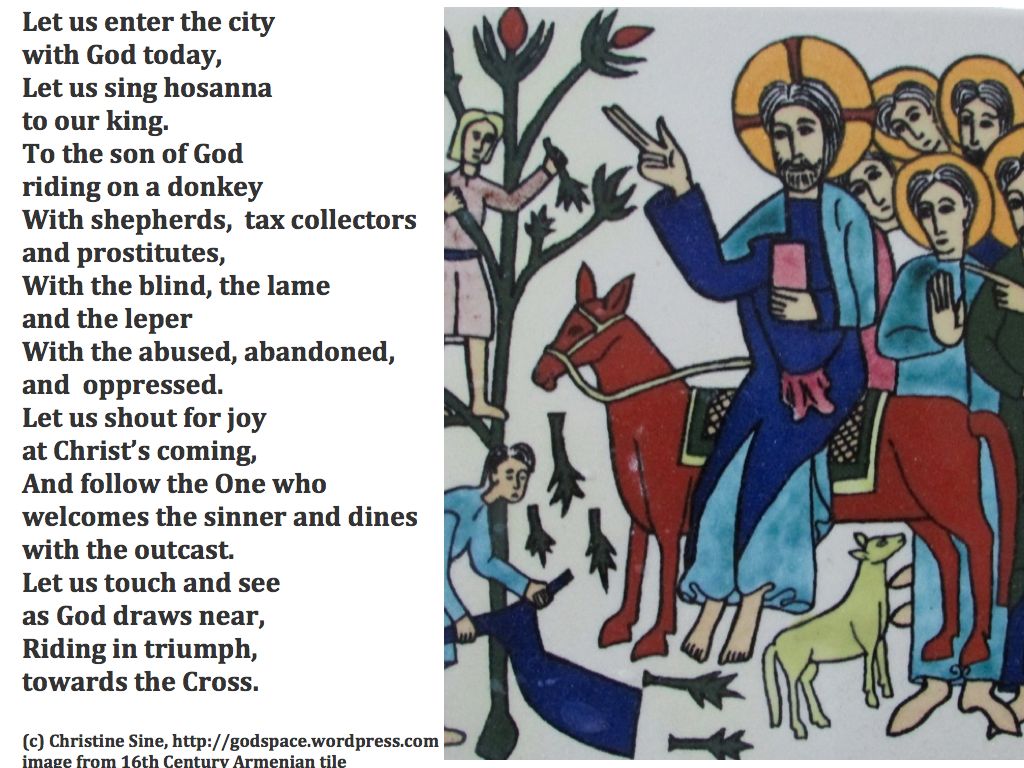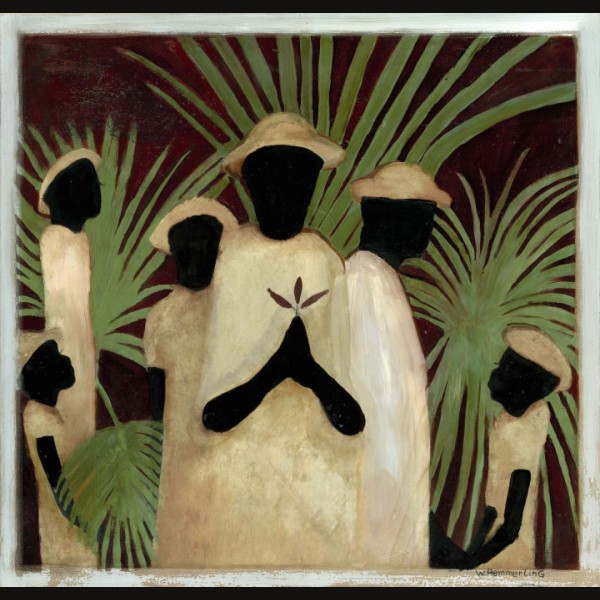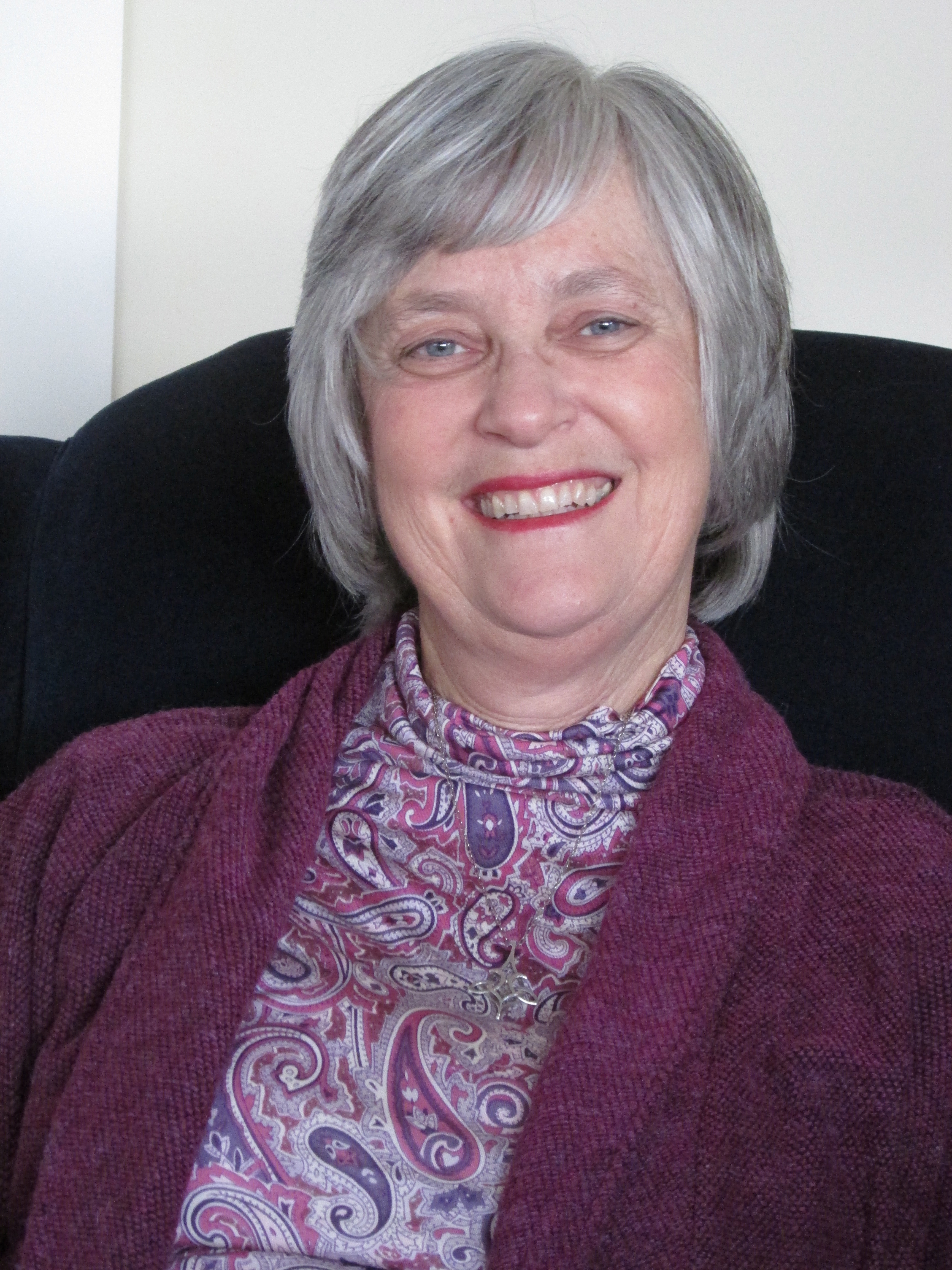I had hoped to use a more contemporary image of the triumphal entry but because of the challenge of getting permission decided to use this instead. However I thought that you might like to see some of the beautiful images I have come across.
I particularly like this one by Dinah Roe Kendall who lives in the U.K

And this by Townsville artist Jan Hynes

Or this by William Hemmerling
Today’s post for the series Return to Our Senses in Lent is written by April Yamasaki. April is a pastor and writer who blogs on spiritual practice, faith, and life at http://aprilyamasaki.com. Her new book is Sacred Pauses: spiritual practices for personal renewal available from Menno Media/Herald Press, Amazon, and your local bookstore.
A year ago, I was pretty much a stranger to social media. Once upon a time, I had joined Facebook to see some pictures sent by a friend, then promptly hid my profile since I hadn’t wanted to take the time to fill it in or find new friends. I had several invitations to LinkedIn that I had dutifully saved instead of deleting. Every so often, one of my sisters would send me an email signed from “your Facebook Liaison,” so I wouldn’t miss out on any family news.
But last May, I finally followed up on my LinkedIn invitations–and yes, they still worked even though they were a few years old. I signed up for my own Facebook, then Google+. I started blogging. By Christmas, I had signed up for Goodreads and Twitter too.
As Lent approached, I learned that one friend was planning to give up Facebook for his Lenten practice. “That’s not for me,” I said to myself. The world of social media was all still new to me. It was something I could dip into or out of at any time. I wasn’t immersed in it every day.
Then a Twitter friend said he was going to “disappear” for just one day on Feb. 27 in honor of the 27 million men, women, and children who’ve disappeared in slavery around the world. I decided to follow suit—no Facebook, no Twitter, no LinkedIn, no Google+, no Goodreads, no blogs. I posted this on my own blog the night before:
I didn’t think anyone would miss me. After all, I don’t blog every day. I don’t post something on Facebook or Google+ every day. Even my daily Twitter activity was just a few tweets. Who would notice?
As it turned out, I noticed—much more than I thought I would. I thought about the millions of people who have disappeared. I wondered about the people they were missing and that were missing them. I held them all in my prayers: Lord have mercy, Christ have mercy. That was the reason I had “disappeared” from social media that day. But I also discovered that I felt more focused. I felt freer from distractions. I felt less pressed for time.
I’ve been reflecting on that experience as I’ve been reading chapter 9 of Return to Our Senses on “Facebook, Blogging, and Go To Prayers.” Is social media “a wonderful tool, or a terrible distraction”? I can see the potential for both.
And so even as the end of Lent is in sight, I’m making a new commitment not just for Lent but for the future: for a once-a-week, social-media-free day, Saturday 6pm – Sunday 6pm, and I’m coupling that with a commitment not to look back endlessly through everything I’ve missed.
The truth is, a person is always missing something. It’s not humanly possible to know everything about everything. And that’s okay. God knows. God is sovereign. I’m resting in that thought.
This year I thought that I would separate out the stations of the Cross from other Good Friday resources as I know many churches like to have Stations of the Cross available for people to walk throughout Holy Week. This year I tried to put together a collection from around the world attempting to highlight some of the challenging issues of our turbulent world that are portrayed. Most of the images are far from the traditional stations of the cross though I have ended the collection with a mimed rendition of Sandi Patty’s Via Dolorosa. If there are other international images you think should be a part of this collection please add them in the comments. Enjoy!
From Australia
From New Zealand
This series comes from Hamilton New Zealand
Cityside Baptist church in Auckland New Zealand has held an exhibit of contemporary icons to reflect on at Easter for a number of years. The photos shown were taken at their 2002 and 2004 presentations.
From Middle East and Sudan –
Here is a heartrending presentation of the stations of the Cross using images of refugees from Iraq and Sudan as spectators and participants. (The stations of the Cross are down the side of the post)
I also came across this interesting set of Jordanian stamps which Mansour Mouasher has found depicting the Stations of the Cross.
From South America
A very powerful presentation of the stations from the perspective of liberation theology by Adolfo Pérez Esquivel of Argentina
From Asia
I enjoyed meditating on this series by a nun in Bangalore India
And another very beautiful, Korean Stations of the Cross by Korean sculptor Choi Jong-tae from Myeong-dong Cathedral.
From Africa
I love this stations of the cross from Hekima College, Nairobi, Kenya. The designs were created by Father Angelbert M. Vang SJ from Yaoude, from the Cameroon who was a well-known historian, poet, musician and designer and executed by a Kenyan artist.
This meditation is a poignant reminder of those who struggle daily to carry crosses we cannot even imagine.
From U.K.
This Stations of the Cross series by Chris Gollon was commissioned by the Church of England for the Church of St John on Bethnal Green, in East London. Gollon took the unusual step of using his own son as the model for Jesus, his daughter as Mary, and his wife as Veronica. Fr Alan Green is cast as Nicodemus, and David Tregunna (Gollon’s friend and agent) as Joseph of Arimathea. The juxtaposition of real figures with imagined ones creates a heightened sense of reality. I think that the images are both compelling and powerful.
From Netherlands
I found this mimed rendition of Sandy Patti’s Via Dolorosa very refreshing.
Today’s post in the series Return to Our Senses in Lent is excerpted from a newsletter I recently received from my friend Edith Yoder Executive Director of Bridge of Hope, a ministry which provides a church based approach to ending homelessness. I was so touched by the video in this post that I wanted to share it with all of you.
“It shouldn’t be this hard and I’m wondering what I’m doing wrong.” These are the words of Kim Ahern, a single mom facing homelessness who’s featured in this powerful video from the Seattle Times entitled “A child’s perspective on homelessness.”
In 2010, Kim moved from Chicago to Seattle because she heard of job opportunities there. When housing fell through, Kim, her 9-year-old son Jack, and their Cockapoo Gracie lived in the King County tent city. Kim explains, “I wish I had Jack’s imagination – without the zombies.”
Kim used the 211 directory to look for housing options and felt that she kept “hitting a wall” until St. Vincent de Paul referred her to Blessed Sacrament. She and Jack were provided with a room and a shared kitchen and bathroom.
Kim spent two months applying for jobs, but wondered what she would do about childcare. “Everyone wants $10-$12/hour and I can’t pay out all I’m making.” She explains that she and Jack dream at night about a new home and furniture. “It’s fun to dream but everything’s on hold. It’s a waiting game.”
My dream for Kim and Jack and families facing homelessness is Bridge of Hope mentoring friends from a local church.
A mentoring group could look at Jack’s “furniture map” and help to make it a reality. Mentoring friends could provide childcare while Kim interviews for jobs. Bridge of Hope staff would provide temporary rental assistance and help Kim to find a job (and job training if needed) so that she can meet expenses for housing, food, childcare, etc.
Please contact me if your church or agency would like to make this dream a reality for a family like Kim, Jack and Gracie. “It shouldn’t be this hard and I’m wondering what I’m doing wrong.” These are the words of Kim Ahern, a single mom facing homelessness who’s featured in this powerful video from the Seattle Times entitled “A child’s perspective on homelessness.”
In 2010, Kim moved from Chicago to Seattle because she heard of job opportunities there. When housing fell through, Kim, her 9-year-old son Jack, and their Cockapoo Gracie lived in the King County tent city. Kim explains, “I wish I had Jack’s imagination – without the zombies.”
Kim used the 211 directory to look for housing options and felt that she kept “hitting a wall” until St. Vincent de Paul referred her to Blessed Sacrament. She and Jack were provided with a room and a shared kitchen and bathroom.
Kim spent two months applying for jobs, but wondered what she would do about childcare. “Everyone wants $10-$12/hour and I can’t pay out all I’m making.” She explains that she and Jack dream at night about a new home and furniture. “It’s fun to dream but everything’s on hold. It’s a waiting game.”
My dream for Kim and Jack and families facing homelessness is Bridge of Hope mentoring friends from a local church.
A mentoring group could look at Jack’s “furniture map” and help to make it a reality. Mentoring friends could provide childcare while Kim interviews for jobs. Bridge of Hope staff would provide temporary rental assistance and help Kim to find a job (and job training if needed) so that she can meet expenses for housing, food, childcare, etc.
Please contact me if your church or agency would like to make this dream a reality for a family like Kim, Jack and Gracie.

Every year before Holy Week I like to update my resources for the season. The list continues to grow so this year I thought I would divide it into several lists: Palm Sunday, Good Friday, and Easter Sunday.
Palm Sunday, this coming Sunday marks, the beginning of Holy week. It celebrates Jesus procession into Jerusalem where people threw down palm fronds to celebrate his entry into the holy city. Many churches process around their churches waving palm fronds and crosses as a symbol of this triumphal event.
Last year I wrote this reflection which contrasts Jesus entry into Jerusalem with the very different entry of Pilot on the other side of the city:
Palm Sunday 2012 – Which Procession Will We Join?
There however a huge number of resources for this season.
As usual Textweek.com has a very comprehensive and excellent list of resources from all over the world to help prepare for this celebration.
Faith at home has some good suggestions on activities to participate in with children.
And Little Takas has a variety of colouring pages available for children of all ages.
What we often don’t realize is that this was a very subversive event, symbolizing the in breaking of God’s kingdom with its upside down values and countercultural ways. Jesus triumphal entry into Jerusalem may have begun with crowds shouting Hosanna but it ends with Good Friday and the apparent triumph of the powers of the Roman Empire and of Satan. It does not end with a gold crown but with a crown of thorns. Jesus triumphal entry ends with his willingness to take into himself all the pain and suffering of our world so that together we can celebrate the beginning of a new procession on Easter Sunday – a procession that leads us into God’s banquet feast and the wonder of God’s eternal world.
I really enjoyed watching this short video on how to make a palm cross for Palm Sunday.
You might also enjoy watching this rendition of All Glory Laud and Honour which is the traditional hymn sung on this day.
The traditional hymn sung on this day is All Glory Laud and Honor
I wrote this morning’s reflection for the series Return to Our Senses in Lent as a result of some the struggles I have experienced in the last few weeks.
This morning I am almost pain free and my head does not feel as though it is full of cotton wool. That may not sound remarkable to most of you but for me it is a wonderful feeling. For the last 5 weeks I have struggled with a bout of facial neuralgia that has slowed me down physically, mentally and even spiritually. I have struggled with constant pain, sleepless nights, and an inability to think straight. And for someone like me who generally memorizes their calendar, rarely writes down appointments and loves to work on half a dozen projects at once, this has been extremely limiting.
Sounds appropriate that this should have hit during Lent, one of my friends commented. At the time I dismissed her comment but now find myself reconsidering. After all, Lent is about craving for wholeness. As we walk with Jesus towards Jerusalem and the cross, we look not just for spiritual healing but for physical healing too. Sometimes, as in the case of my facial pain, there is little we can do to bring about that healing except wait patiently, pray and hope for a better world. At other times we can actively work towards healing, changing our lifestyle and daily activities to nurture the healing process. And always there is that amazing sense of freedom when our pain or whatever other issues we struggle with, disappear and we are released.
So it is with our faith. The healing from the brokenness within does not always come easily and sometimes we feel there is little, if anything, we can do to hasten it. We are acutely aware of the pain, we stay awake at night agonizing over its impact on our lives and those of others, but we feel incapable of changing. All we can do is pray and hope.
Then suddenly something changes, we don’t know why or how, but suddenly the burdens that have so weighed us down are lifted and we feel life has returned. It is as though we have arrived at the foot of the cross and been able to lay them down. Fortunately that is not the end of the story however.
The freedom, the rejoicing, the celebration in our spirits is huge, not because we have reached the cross but because in this moment we have looked beyond the cross to the resurrection and the new life of God’s eternal world. May we always remember that the cross is not an end but a beginning, not a failure but a triumph, not a death but an entrance into new life.
Today’s Lenten post for the series Return to Our Senses in Lent is written by my husband Tom Sine. Tom is a futurist, author, and chief hospitality guy for Mustard Seed Associates. It was first posted on the MSA website where Tom is now blogging each week.
In 1982 I took my first pilgrimage to Iona to experience the new discipline for me of listening for God in one of the holy places. I got more than I bargained for. I not only had a very deep experience of what Celtic Christians call “thin places” where the dimension between this world and the next becomes one. As a result of that first pilgrimage I became acquainted with Patrick and a number of his friends and followers and it has radically changed my view of what it means to be a follower of Jesus.
At age 16 Patrick was kidnapped from his home in England and was taken by Irish traders as slave to Ireland. He was forced to care for sheep. He learned about the people and Irish culture but being enslaved most importantly he learned a life of prayer was essential to his difficult life.. After 6 years he escaped and returned to his family. Then God called him to return to Ireland as a missionary. In three decades Patrick and his compatriots saw Ireland become largely converted to Christianity. The Irish, Scots and English were introduced to much more of a whole life faith than was not common then or now.
What I have learned from Patrick, Columba, Hilda, Bridget and Cuthbert is that prayer is not 15 minute break in the day but prayer was intended to permeate all of life. Celtic Christians had prayers for rising in the morning, prayers planting seeds in the day and prayers for banking fires at night. Celtic Christians not only were devoted to a life of prayer, but a love of God’s creation and a care for the poor. I find younger Christians who are hungry for a more authentic whole life faith are often drawn to Celtic Christian faith.
If you would like to have a small taste of the Celtic faith join us for our annual Celtic Christian Prayer Retreat on Camano Island August 10th &11th.
As we head into the final days of the season of Lent and as we celebrate St. Patirck’s Day on Sunday… I invite you to join Saint Patrick and the many Celtic Saints in taking time to listen to our God by quietly repeating Patrick’s prayer and listen to what God might say to you.
Christ with me, Christ before me, Christ behind me, Christ in me, Christ beneath me, Christ above me, Christ on my right, Christ on my left Christ where I lie, Christ where I sit, Christ where I arise Christ in the heart of every man who thinks of me, Christ in the mouth of every man who speaks of me, Christ in every eye that sees me, Christ in every ear that hears me.Write me and let me know what you hear from God as you quietly read Patrick’s prayer and listen for God’s whispers to you.
As an Amazon Associate, I receive a small amount for purchases made through appropriate links.
Thank you for supporting Godspace in this way.
When referencing or quoting Godspace Light, please be sure to include the Author (Christine Sine unless otherwise noted), the Title of the article or resource, the Source link where appropriate, and ©Godspacelight.com. Thank you!






